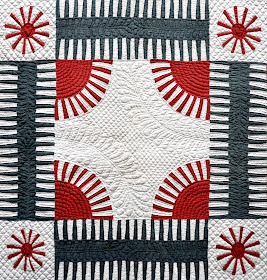 |
| 1850s Kentucky quilt, pattern later known as New York Beauty |
The process of documenting quilts is a lot of fun. There's a form to fill out, and in my case, my collection will be its own entity on the Quilt Index. So I have my own form. It is adapted from the Oregon Quilt Project form, which is now available online! The form captures physical description details, such as materials, technique, condition, machine or hand work, dates, inscriptions, colors, and history. It's a great opportunity to look closely at a quilt.
 |
| Look at the detail! Susan wondered how much thread was used. |
The same was true for the next quilt, made in 1868 by a member of the MacMillan Family in Monroe County, Kentucky. This famous quilt was first documented by the Kentucky Quilt project in the 1980s, and was featured in the book Kentucky Quilts.
If you've read my blog, you may recall the MacMillan Family Quilt is the one we recently updated on the Quilt Index. And you may also wonder, why document it again? I asked Beth Donaldson how she felt about it, and she thought it would be best to do my own documentation of the quilt. After I do that, there will eventually be two records for the same quilt, linked. How cool is that?
One of the most interesting discussions we had was about the color of the thread on the MacMillan Family quilt, particularly the thread used to quilt the red areas. On the front of the quilt, the thread looks white. On the back, there are traces of red color, mostly faded out. We wondered if the thread had picked up color from the red fabric, but decided any migrating red would've been seen in more than just thread. Brains thoroughly wracked, and in need of sustenance, we adjourned to the kitchen for some chocolate chip cookies. Later in the day, I did one more quilt, the one I call the "Box of Crayons" quilt.
It was a lot of fun documenting quilts. I'll be continuing my documentation of this group of quilts through February, and if anyone's in the area and wants to join in, please send me a note. It's good training. Everyone who loves quilts should know how to document quilts. Thank you, Susan Beal and Michelle Freedman for helping me document two of the most important quilts in my "New York Beauty" collection. I'm thrilled to know PMQG is planning to add quilt documentation to the menu.





No comments:
Post a Comment